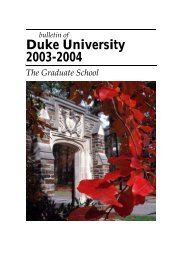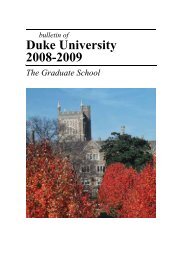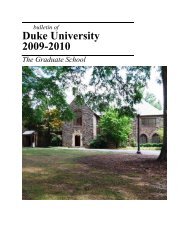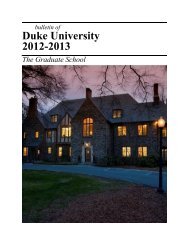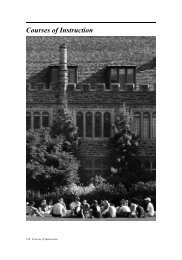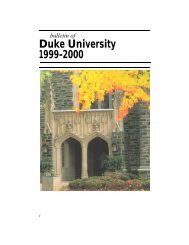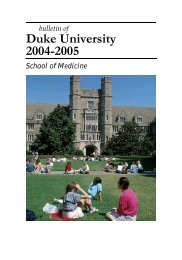2005-06 - Office of the Registrar - Duke University
2005-06 - Office of the Registrar - Duke University
2005-06 - Office of the Registrar - Duke University
You also want an ePaper? Increase the reach of your titles
YUMPU automatically turns print PDFs into web optimized ePapers that Google loves.
for graduate study in one <strong>of</strong> <strong>the</strong>se areas should be directed to <strong>the</strong> director <strong>of</strong> graduate studies<br />
<strong>of</strong> any <strong>of</strong> <strong>the</strong> five departments. For information pertaining to <strong>the</strong> use <strong>of</strong> <strong>the</strong> Primate Center,<br />
graduate studies, or availability <strong>of</strong> research space, write to Dr. William L. Hylander,<br />
Director, <strong>Duke</strong> <strong>University</strong> Primate Center, 3705 Erwin Road, Durham, North Carolina<br />
27705.<br />
Psychological and Brain Sciences Laboratories. Our department faculty reside in<br />
three locations: <strong>the</strong> Psychology/Sociology building, <strong>the</strong> Center for Cognitive<br />
Neurosciences, and <strong>the</strong> Genome Science Research Building II. These facilities contain state<strong>of</strong>-<strong>the</strong>-art<br />
laboratories to study perception and cognition in human infants and adults—<br />
including <strong>the</strong> areas <strong>of</strong> autobiographical memory, developmental cognitive and affective<br />
neuroscience, and visual perception. Equipment is available for electrophysiology, eye<br />
tracking, and video recording. There are also laboratories equipped for <strong>the</strong> study <strong>of</strong> animal<br />
learning and cognition, and time and number perception in rats, mice, pigeons, fish, and<br />
monkeys. These labs are designed to conduct research in behavioral and computational<br />
neuroscience and are supported by facilities for animal housing, surgery, histology,<br />
microscopy, and electrophysiology. There is support for building <strong>of</strong> new apparatus, and for<br />
computer networking. Additional facilities for access to prosimian animal models, patient<br />
populations, and for brain imaging are available in <strong>Duke</strong>’s Brain Imaging and Analysis<br />
Center, <strong>the</strong> nearby Primate Center, and <strong>the</strong> <strong>Duke</strong> and V.A. Medical Centers.<br />
Chemistry Laboratories. The Department <strong>of</strong> Chemistry is housed in <strong>the</strong> P. M. Gross<br />
Chemical Laboratory, a building containing 146,400 square feet <strong>of</strong> total area, with additional<br />
research space in <strong>the</strong> Levine Science Research Center to accommodate chemistry at <strong>the</strong><br />
biology interface. This well-equipped chemical laboratory provides conditions conducive to<br />
research in many areas <strong>of</strong> current interest. Major shared instruments, including those for<br />
nuclear magnetic resonance and mass spectrometry, are housed in <strong>the</strong> departmental<br />
instrumentation facility, along with optical and o<strong>the</strong>r instrumentation, including FTIR, UV-<br />
VIS, and fluorescence spectrometers. A wide array <strong>of</strong> more specialized instrumentation is<br />
available in <strong>the</strong> various research laboratories, from ultrafast laser systems to atomic force<br />
microscopes to automated solid-phase syn<strong>the</strong>sizers. O<strong>the</strong>r major facilities on campus<br />
include <strong>the</strong> Free Electron Laser Laboratory and <strong>the</strong> <strong>University</strong> NMR Center, which<br />
maintains several ultra high field NMR instruments. A broad range <strong>of</strong> instrumentation for<br />
biological and materials science applications is accessible in <strong>the</strong> Medical Center and School<br />
<strong>of</strong> Engineering, with additional facilities available at <strong>the</strong> neighboring universities and in<br />
Research Triangle Park, including those for X-ray diffraction and structure determination.<br />
Computing facilities in chemistry include SGI and Redhat Linux workstations,<br />
Beowulf clusters, and clusters <strong>of</strong> PC’s associated with <strong>the</strong> teaching laboratories and <strong>the</strong><br />
library. The department is linked to <strong>the</strong> university's high speed fiber optic network and to<br />
<strong>the</strong> university’s high performance shared computing cluster. In addition, <strong>the</strong> department<br />
has state-<strong>of</strong>-<strong>the</strong>-art computer/video projection systems in its lecture halls and is installing<br />
wireless networking for incorporation <strong>of</strong> <strong>the</strong> latest computational research tools into <strong>the</strong><br />
undergraduate chemistry curriculum.<br />
The Department <strong>of</strong> Chemistry Library, with holdings <strong>of</strong> approximately 50,000<br />
volumes, is also located in <strong>the</strong> P.M. Gross Chemical Laboratory. The library receives over<br />
500 current periodicals and serial subscriptions and has computer facilities for complete<br />
information retrieval.<br />
Physics Laboratories. The Physics Building houses research and instruction in <strong>the</strong><br />
Departments <strong>of</strong> Physics and Ma<strong>the</strong>matics. Additional space is provided by <strong>the</strong> adjacent<br />
Nuclear Building (TUNL) and Free Electron Laser (FEL) Laboratory Buildings. Graduate<br />
students studying in <strong>the</strong>se two programs usually have <strong>of</strong>fices in <strong>the</strong>se buildings.<br />
About half <strong>of</strong> <strong>the</strong> Physics space is devoted to research laboratories for <strong>the</strong> department's<br />
programs. Special equipment includes: ultrafast, high power, short wavelength, and farinfrared<br />
lasers; a 45-MeV electron linear accelerator driving an infrared free electron laser<br />
(FEL) and a 1 GeV linear accelerator and high current electron storage ring driving an<br />
298 Resources for Study



